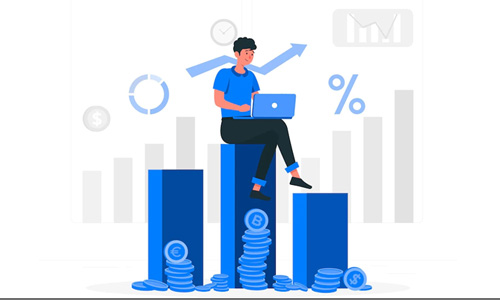Best Investment Plan for 5 Years
Invest smart today for a better tomorrow
Investing is not just about growing or multiplying money but a crucial step towards securing one's future and fulfilling life's many aspirations. Building a financial corpus is essential not only for unforeseen emergencies but also to realise dreams like buying a home, funding education, or enjoying a comfortable retirement. Awareness of the best investment options in the market can make a significant difference in how your wealth grows.
Whether you're looking for a 5 years saving plan, a monthly investment plan for 5 years, or the best monthly investment plan for 5 years, understanding your choices and financial considerations is key.
Table of Content
This article will guide you through the most promising 5 year savings plans and help you make informed decisions for a prosperous future.
Who Can Opt for the Best Investment Plan for 5 Years?
Investment is a personal decision that varies depending on individual goals and circumstances. A 5-year investment plan is a middle-ground, offering more growth potential than short-term plans while requiring less commitment than long-term investments.
So, who might find a 5-year investment horizon suitable?
- Young Professionals: Starting early with a 5-year plan can provide a head start on wealth creation, helping young professionals harness the power of compound interest.
- Couples Planning for Major Life Events: Whether it's buying a house, having a child, or taking a sabbatical, having an investment cushion for such milestones is always beneficial.
- Parents with School-Age Children: With education costs on the rise, starting a 5-year investment plan can prepare parents for impending college or higher education expenses.
- Retirees Seeking Short-Term Growth: Not all retirees look for immediate returns. A 5-year plan can be ideal for those willing to keep some funds invested a little longer.
- Risk-Averse Investors: Those who hesitate about the volatility of long-term markets might find comfort in the comparatively stable nature of 5-year investments.
- People with Fixed Financial Goals: For individuals with a clear financial target set for the next half-decade, a 5-year savings plan offers a focused approach to achieving that aim.
- Individuals Seeking Diversification: Adding a 5-year plan to an existing portfolio can bring balance and spread risk, especially if one has primarily short-term or excessively long-term investments.
Benefits of Best Investment Plans for 5 Years
The Indian financial landscape is diverse, with an array of investment opportunities available to cater to both short and long-term objectives. With the abundance of options, it becomes essential to understand the advantages of a specific tenure like the 5 years saving plan.
Let's take a look at some of the benefits of opting for the best monthly investment plan for 5 years or similar 5 years savings plans:
- Optimal Growth Potential: A 5-year investment window provides ample time for money to grow, striking a balance between short and long-term returns.
- Lesser Volatility: While not entirely immune, 5-year plans typically witness lesser market volatility than ultra-short-term investments.
- Flexibility: Monthly investment plans for 5 years allow investors to contribute periodically, facilitating budget-friendly investments and building financial discipline in the process.
- Diversification: These plans often let you diversify across assets so that risks are spread and not concentrated.
- Liquidity: Unlike longer tenures, 5 years savings plans tend to offer relatively better liquidity. This way, you can easily access funds if necessary.
- Compound Interest: With a timeframe like 5 years, investors can truly leverage the magic of compound interest and watch their investments multiply.
- Suitable for Various Goals: Whether it's funding a child's education, buying a car, or planning a big vacation, a 5-year plan caters to a range of financial objectives.
- Informed Decisions: Given the myriad of investment options in 2023, focusing on a 5-year horizon helps in narrowing down choices, making the decision-making process less overwhelming.
Best 5 Years Saving Plan
Investment is about striking the right balance between risk and reward. For those who prefer the safety of their corpus without locking in their money for extended periods, 5-year investment plans can be ideal.
Here's a closer look at some of the most recommended 5-year savings plans:
1.) ULIPs (Unit Linked Insurance Plans)
ULIPs present a unique proposition in the world of finance by fusing insurance and investment. The main objective of these plans is to provide both a life cover and a means to grow one's wealth. In recent years, with changes to their structure and fee schedules, ULIPs have gained popularity for wealth creation.
Features
- Dual Benefit: The beauty of ULIPs lies in their twofold advantage. While a portion of the premium goes into life coverage, the rest is invested in funds of the policyholder’s choice — ranging from equity to debt or a mix — based on risk appetite.
- Fund Flexibility: One of the standout features of ULIPs is the liberty to switch between funds, allowing investors to adapt to market conditions.
- Premium Redirection: Investors have the choice to redirect future premiums to different funds if they wish to change their investment strategy.
- Partial Withdrawals: After a mandatory lock-in period (usually 5 years), investors can make partial withdrawals, providing liquidity when needed.
- Best Suited For: Individuals who are open to medium-risk ventures and desire both insurance and investment under a single umbrella. These plans are especially apt for those who may not have the time or expertise to manage separate insurance and investment avenues.
2.) Traditional Plans
Harking back to the earliest form of life insurance, traditional plans are designed for investors who gravitate towards security and predictability. The primary purpose here is to offer a safeguard against life's uncertainties while guaranteeing a certain return.
Features
- Stable Returns: Unlike market-linked plans, traditional plans pledge fixed income returns, making them less volatile and more dependable.
- Risk Coverage: They inherently offer protection against unforeseen life events, ensuring beneficiaries receive a sum in case of the policyholder's demise.
- Life Protection: Beyond the financial aspects, these plans offer peace of mind through life insurance coverage.
- Hands-off Approach: With guaranteed returns and bonuses, investors can remain stress-free without needing to track market fluctuations.
- Best Suited For: Conservative investors who prioritise capital protection above all else. Traditional plans are ideal for those who want a mix of insurance and guaranteed returns without the unpredictability of the market.
3.) Recurring Deposits (RD)
Recurring Deposits serve as an ideal bridge between savings accounts and fixed deposits. The essence of RD is to promote disciplined, regular savings without the need for a lump-sum investment. They are perfect for individuals who aim to save a fixed amount every month and earn interest on it.
Features
- Flexible Tenures: RDs come with varied durations — starting from as short as 6 months and extending up to 10 years — to offer adaptability to the investor's financial plan.
- Safe & Sound: Backed by banking institutions or post offices, RDs offer a high degree of safety for your capital.
- Structured Contributions: RDs necessitate monthly deposits, which encourages consistent savings and makes financial discipline inherent.
- Choices in Types: Investors can choose between Bank RDs, which often have online facilities and slightly better rates, or Postal RDs, widely accessible across India.
- Best Suited For: Savers who prefer a systematic approach to saving without the pressure of a lump-sum deposit. RDs resonate with those who appreciate the predictability of returns and a structured savings routine.
4.) Monthly Income Schemes (MIS)
Monthly Income Schemes serve as a reliable source of consistent income, particularly favoured by retirees and individuals seeking a regular payout. The primary objective is to provide a fixed interest on the lump sum investment every month.
Features
- Stable Monthly Income: The most crucial feature of these plans, as the name suggests, is the guaranteed monthly return that provides a predictable income stream.
- Flexible Platforms: Both banks and post offices offer MIS, giving investors choices based on their preferences and trust.
- Initial Investment: While such schemes demand a lump sum deposit at the beginning, the subsequent monthly returns can be a source of regular income.
- Safety Net: This is true especially when considering postal MIS, which is backed by the government and ensures a high degree of safety.
- Best Suited For: Ideal for retirees and individuals seeking a fixed monthly income. Those who have a lump sum to invest and want a stable, regular return may find MIS highly appealing.
5.) Fixed Deposits (FD)
One of the oldest and most trusted investment avenues, Fixed Deposits allow investors to deposit a lump sum for a predetermined period and earn interest. The primary goal is capital preservation along with a guaranteed interest income.
Features
- Guaranteed Returns: Interest rates are set at the outset, providing clarity on the returns irrespective of market fluctuations.
- Flexible Tenures: FDs offer a wide range of tenures, typically from a few days to a decade, catering to both short-term and long-term needs.
- Loan Against FD: Several banks offer the facility to avail of a loan against your FD, which ensures liquidity without requiring you to break the deposit.
- Digital Convenience: Modern banking has enabled online creation and management of FDs, making it exceedingly convenient.
- Best Suited For: Conservative investors wanting a no-risk, predictable return on their savings. FDs are perfect for those not keen on market-linked products and who prioritise capital safety.
6.) Savings Account
The most basic form of banking, a savings account offers a safe place to keep your money while earning interest. Although not primarily an investment vehicle, it still provides returns and unmatched liquidity.
Features
- Immediate Liquidity: Money in a savings account is always accessible, be it through ATM withdrawals, online transfers, or branch visits.
- Minimal Risk: Being insured by banking institutions, the capital remains safe and risk-free.
- No Lock-in: There's no commitment period, and funds can be added or withdrawn at will.
- Best Suited For: Almost everyone, especially those who need a primary account for transactions and a safe place for their funds. A savings account is a fundamental need, providing both safety and moderate returns.
7.) Liquid Funds
Liquid funds make up a category of mutual funds that invest primarily in short-term money market instruments like treasury bills, commercial paper, and term deposits. The primary objective is to offer high liquidity and safety with modest returns.
These funds are seen as an alternative to keeping excess funds in a savings account as they can potentially provide higher returns.
Features
- High Liquidity: As the name suggests, these funds provide quick access to cash. Most liquid fund redemptions are processed within one business day.
- Low Risk: Investments are made in high-credit-quality instruments that have a short maturity period, reducing both credit and interest rate risks.
- No Exit Load: Generally, there's no exit load with liquid funds. This means investors don't have to pay any charges when withdrawing their investments.
- Flexible Entry and Exit: There's usually no minimum investment period, and one can invest or redeem any day (barring a few exceptions).
- Optimised Returns: While they may offer slightly higher returns than regular savings accounts, it's essential to note that the returns are neither guaranteed nor very high in comparison to other riskier assets.
- Best Suited For: Investors looking for a safe place to park their surplus funds for a short duration. It's suitable for those who want better returns than a savings account but without significant exposure to risks. Business entities also use liquid funds to manage their short-term cash needs.
Wrapping Up
The concept of investing has long transcended just the idea of multiplying money. Today, it's about laying a foundation for future security and nurturing aspirations. Central to this is building a financial cushion for unpredictable circumstances and notable life goals like home ownership, quality education, or retirement. Knowledge of the available investment avenues, especially those tailored for a specific duration, can significantly affect one's wealth trajectory.
Whether an individual seeks a 5 years saving plan, contemplates a monthly investment plan for 5 years, or is on the hunt for the best monthly investment plan for 5 years, being well-informed is of the utmost importance.
This article provided a comprehensive exploration of the prime 5 years savings plans, spanning from insurance-investment combos like ULIPs to classic options like Fixed Deposits. Each investment vehicle is uniquely poised to cater to varied financial goals and risk appetites.
More From Investment
- Recents Articles
- Popular Articles


















.jpg)

.jpg)
.jpg)

.jpg)
























